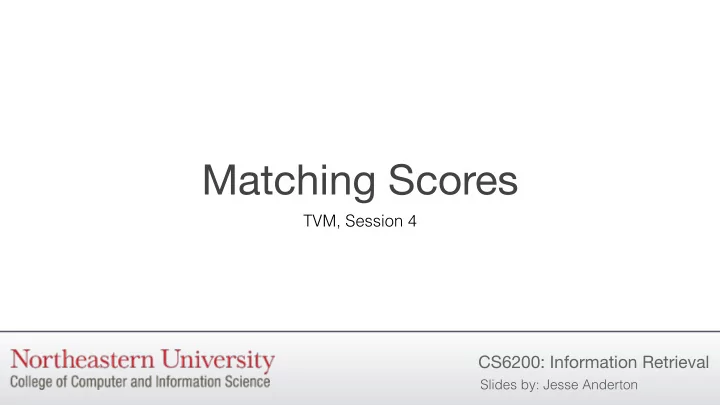

Matching Scores TVM, Session 4 CS6200: Information Retrieval Slides by: Jesse Anderton
Finding Similar Vectors �� ( q t − d t ) 2 • Imagine that we have perfect term dist ( q , d ) := t scores: our vectors exactly capture 1 the document’s (or query’s) sim ( q , d ) := 1 + dist ( q , d ) meaning. Play TF Distance Similarity • How can we compare two of these Henry VI, vectors so we can rank the 1 0 1.0 part 2 documents? Hamlet 1 0 1.0 • What’s wrong? Antony and • Let’s try a similarity function based 4 4.59 0.179 Cleopatra ‣ In the query’s term vector, TF=1. on the Euclidean distance between Coriolanus 109 165.40 0.006 the vectors. Julius ‣ Documents with TF > 1 are further 379 578.9 0.002 Caesar from the query, so have lower Plays for query “brutus” using TF-IDF term scores
Dot Product Similarity • We used the dot product in module 1. How does that work? sim ( q , d ) := q · d • For many documents, it gives the results we want. Play TF Similarity • However, imagine building a document by Henry VI, part 2 1 2.34 repeating the contents of some other Hamlet 1 2.34 document. Antony and 4 9.38 Cleopatra • Should two copies of Julius Caesar really Coriolanus 109 255.65 match better than a single copy? Julius Caesar 379 888.91 • Should “The Complete Plays of Julius Caesar x 2 758 1777.83 Shakespeare” match better than individual Julius Caesar x 3 1137 2666.74 plays it contains? Plays for query “brutus” using TF-IDF term scores
Cosine Similarity q · d sim ( q , d ) := • Cosine Similarity solves the � q � · � d � problems of both Euclidean-based q · d = similarity and the dot product. �� �� i q 2 i d 2 i · i q d ‣ Instead of using distance = · �� �� i q 2 i d 2 between the vectors, we should i i use the angle between them. Play TF Similarity Henry VI, part 2 1 0.002 ‣ Instead of using the dot product, Antony and we should use a length- 4 0.004 Cleopatra normalized dot product. That is, Coriolanus 109 0.122 convert to unit vectors and take Julius Caesar 379 0.550 their dot product. Julius Caesar x 2 758 0.550 Plays for query “brutus” using TF-IDF term scores
Approximating Cosine Similarity q d • The normalization term for cosine sim ( q , d ) ≈ · � � similarity can’t be calculated in len ( q ) len ( d ) advance, if it depends on df t or cf t . • For faster querying, we sometimes Play TF Similarity approximate it using the number of Henry VI, part 2 1 0.014 terms in the document. Antony and 4 0.056 Cleopatra • This preserves some information Coriolanus 109 1.478 about relative document length, Julius Caesar 379 6.109 Julius Caesar x 2 758 8.639 which can sometimes be helpful. Plays for query “brutus” using TF-IDF term scores
Pivoted Normalized Document Length • Some long documents have many short sections, each relevant to a different query. sim ( q , d ) := q d • These are hurt by Cosine Similarity a � d � + ( 1 � a ) piv , � q � · because they contain many more distinct terms than average. 0 < a < 1 ; piv determined empirically* � q d • If we normalize by a number less than the au d + ( 1 � a ) piv , � q � · length for short documents, and more than u d is # unique terms in d the length for long documents, we can give a slight boost to longer documents. • This comes in both exact and approximate forms. * See: http://nlp.stanford.edu/IR-book/html/htmledition/pivoted-normalized-document-length-1.html
SMART Notation • VSM weights can be denoted as ddd.qqq , where ddd indicates the scheme for document weights and qqq the scheme for queries. The triples are: term frequency, doc frequency, normalization. • A common choice is lnc.ltc: document vectors use log term frequency and cosine normalization, and query vectors use log term frequency, IDF, and cosine normalization. Image from: http://nlp.stanford.edu/IR-book/html/htmledition/document-and-query-weighting-schemes-1.html
Wrapping Up • Ultimately, the choice of a scoring system to use depends on a balance between accuracy and performance. • Ignoring document length entirely with cosine similarity is a big improvement over the simple dot product, but it turns out that there are subtle cases when document length information is helpful. • Next, we’ll look at ways to efficiently calculate these scores at query time.
Recommend
More recommend